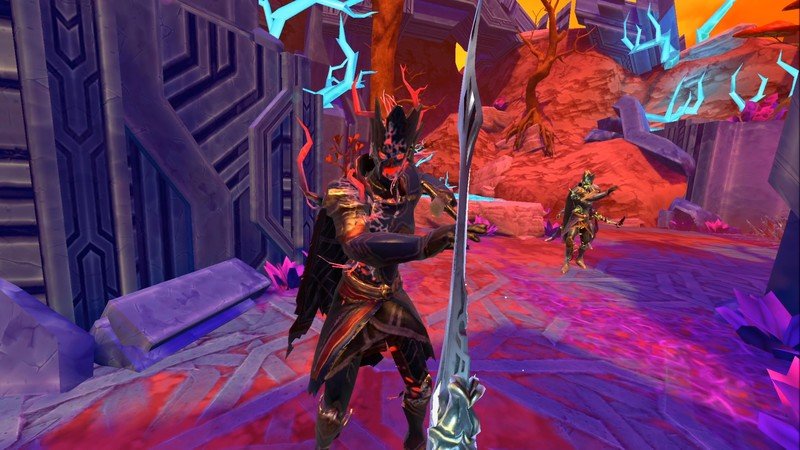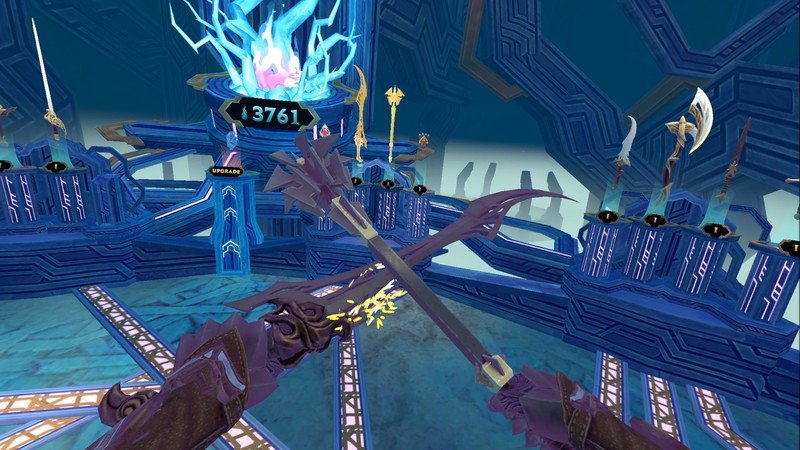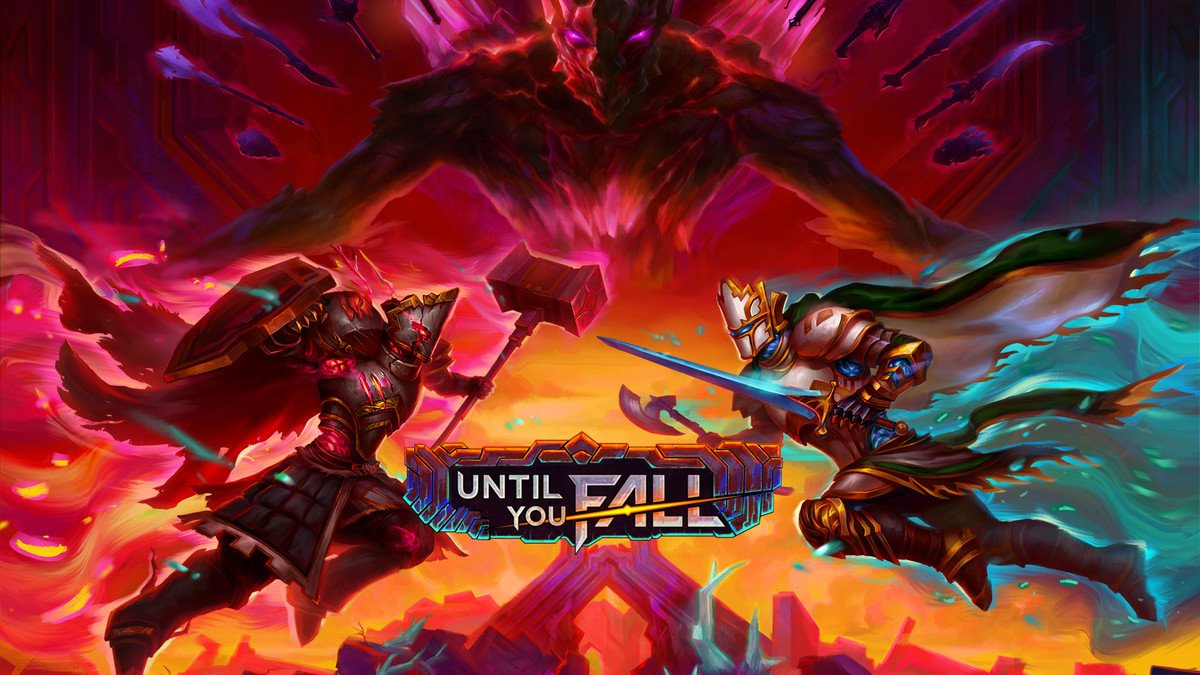Android Central Verdict
$25 at Oculus StoreBottom line: Until You Fall will challenge your will to fight, kill you ruthlessly, and bring you back to do it all over again. It's an incredibly beautiful, satisfying roguelite with a killer soundtrack and addicting hack-and-slash gameplay.
Pros
- +
Solid, visceral combat
- +
Impressive physics and weapon weight
- +
As simple or deep as you make it
- +
Highly replayable
- +
Several difficulty levels
- +
Height adjustment
Cons
- -
Light on story elements
Why you can trust Android Central
Until You Fall's namesake perfectly describes the game from the get-go. Head out into battle, fight until you fall, be miraculously reborn, and do it all over again. It's a visceral melee combat game that perfectly embodies the virtual reality medium it uses, and it's going to kick your butt time and time again.
Until You Fall launched for the Early Access program on Steam and Oculus Rift with the promise of an eventual PlayStation VR, Oculus Quest, and Oculus Quest 2 release. One year later, as the game graduates to version 1.0, Until You Fall is simultaneously releasing on Oculus Quest and PSVR on September 29. The PC 1.0 versions will be launching on Steam and Oculus latr this Fall, but are available now in Early Access. This review is based on the Oculus Quest version, specifically, but you'll find the experience to be identical on all platforms.
The Oculus Quest is going to be the preferred platform to play the game on, as this VR hack-and-slash roguelite is designed to pit you against multiple enemies at once. That just works better on a system that's not only completely wireless, but can also allow players to walk around the room at will to duck, dodge, and better strategize in a fight. You'll be doing plenty of battling throughout each round of the game, making your way through the tiers and eventually fighting end big end boss, upgrading your weapons and abilities along the way.
Neon-drenched fantasy
Until You Fall Visuals, performance, and audio

| Category | Until You Fall |
|---|---|
| Title | Until You Fall |
| Developer | Schell Games |
| Publisher | Schell Games |
| Genre | Hack-and-Slash Roguelite |
| Players | Single |
| Platforms | Oculus Quest, PlayStation VR, SteamVR, Oculus Rift |
| Launch Price | $25 |
Until You Fall is a quasi-medieval, neon-drenched fantasy hack-and-slash roguelite with a synth-wave soundtrack. Sound like nothing you've ever heard of before? That's certainly what I thought the first time I played it over a year ago, and the version 1.0 release that launches on the Oculus Quest, PlayStation VR, and PC VR platforms has further fleshed out this bizarre, yet oddly perfect mix of themes. All screenshots and video in this review are from the Quest/PSVR version of the game.
Visually, there are several cosmetic differences between the Quest/PSVR version and the PC VR versions, but, to be frank, I didn't find myself caring about them at all. Because Until You Fall's world is so stylized, it translates perfectly to lower power platforms. This sentiment is further carried because of the absolutely stellar performance of the game, which never sees a drop or struggle, even on the humble Oculus Quest hardware. That's particularly important since missing any frame of the action could lead to certain death.
As you progress in the game, you'll travel through several tiers of enemies, each world tier carrying a distinct color palette and style. The initial green tier palette is far from friendly and inviting, but it only gets more foreboding as you progress into the blue/purples of tier 2, and finally, the deep crimson of the third tier.
Get the latest news from Android Central, your trusted companion in the world of Android
Likewise, you'll find enemies change as you progress, from the zombie-like throwaway enemies and hulking behemoths with giant tower shields at the beginning of the first tier to the wraith-like rogues and haunted knights in the second and third tiers. Enemies have clearly identifiable fighting styles that can be easily recalled when seeing each of their distinctive looks.
Likewise, the pumping synth-wave soundtrack will have you feeling in the groove the entire time and lends an incredibly satisfying feeling to an already visually delicious game. Until You Fall also makes perfect use of positional audio, so you'll definitely want to be playing this one with a pair of great headphones on. Without headphones, there's a high likelihood that you might end up getting flanked by an enemy you weren't visibly aware of.
Feels really real
Until You Fall Impressive physics-based combat

One of the hardest things to achieve in VR is the feeling of a physical object. After all, you are holding controllers that weigh only a few hundred grams at most. Mimicking an ax that weighs in excess of 1,000 grams or more, therefore, seems like it would be nearly impossible. But Schell Games did the impossible when Until You Fall launched in early access in August 2019, and it helped pave the way for other developers who are looking to implement a physics system that gives realistic weight to virtual objects.
How does it work? By introducing a delay to heavier weapons that makes them appear heavy to your brain. When you swing a dagger, your virtual arm and weapon follow your real-world movements to a tee. While using a heavy ace, mace, or sword, however, your virtual arm and weapon noticeably fall behind your real arm and controller, introducing a sense of weight to your brain. You'll quickly become aware of how difficult it is to block with a heavy weapon in combat while, on the flip side, a heavy weapon is best for finishing off opponents in one fell swoop.
Enemies can be approached in one of two ways: walking or dashing. Dashing begins the attack sequence and will hit harder the further out you dash from. Attacks can also be interrupted with dash attacks, but those close range dashes won't do as much damage. As you wail on enemies, they'll eventually block and then counter-attack, with different enemies exhibiting appropriate behaviors based on their class. Stronger enemies will even require you to physically dodge some attacks by ducking or dodging.
When an enemy attacks, a brief blade graphic will appear on screen, denoting the direction and angle you need to hold your weapon at in order to block the attack. More difficult enemies will unleash a barrage of attacks on you, meaning you'll need to block several attacks until it's your turn. Each weapon features its own stats, including a blocking stat. So, while heavy weapons are more difficult to block with, they'll keep your health bar high for longer than a light weapon.
The further into the level tiers you go, the faster and more unforgiving enemies become. Even from the get-go, though, enemies will gang up on you and attack from multiple angles, encouraging players to strategize better each time they go through the gamut. You won't just need to play hard — you'll need to play smart.
Out of breath, out of health
Until You Fall Upgrades and progression

As said before, Until You Fall is a hack-and-slash roguelite that's structured in a way that your goal is to fight until you die, resurrect, upgrade, and do it all over again. Each time you begin, you'll be able to change the difficulty level, choosing between three challenge types from the beginning. If you are a master swordsman and can somehow get through all the tiers, you'll eventually unlock a fourth difficulty level that I'm simply not good enough to achieve. Maybe one day.
You'll then walk into a portal and be transported to the beginning of the highest tier you've achieved. That's great for progression because, otherwise, you'd be making your way through dozens of areas each time just to get back to where you died. At least with this, you get a "checkpoint" with every level tier. Each tier is comprised of around 10 areas to complete, each with an entrance and exit point. Most areas are pretty straightforward in design but get more complicated as you progress.
Each area also spawns a different number of enemies, so while you'll be fighting 3 or 4 enemies in one area, you might fight 8 in the next. Choosing to only fight one or two at a time is the key to not getting overwhelmed but, if you do, you can always activate each weapon's superpower once it's charged up. Superpowers are charged through regular combat and blocking, so you'll be earning each super throughout most areas.
The end of each area presents players with three random crystals to choose from. You'll pick the one that best suits your situation, whether that's temporarily upgrading your weapon's power, adding a special attack, healing you up, or just stocking up on Aether, which is the game's currency. Each time you die, you'll be awarded a certain amount of Aether and can then use that to forge weapons, upgrades, and several other important items.
Weapons are categorized into four archetypes, each archetype aimed toward different play styles. The Tactician is well-balanced between strong attacks and magical prowess, with weapons like the Engraved Arming Sword that you start with. The Bruiser is an aggressive fighter type that uses heavy weapons like Vestal's Wrath, a massive mace that's designed to deal a lot of damage. The Rogue utilizes lighter weapons like the Rokari Keenblade to deal quick damage and allow for quick blocks, as well as giving players faster movement.
The last weapon archetype is The Spellsword, which utilizes weapons like the High Arcanist's Blade, a magical dagger that can immobilize opponents as you wail on them. Since there are no actual player classes in Until You Fall, your upgrade path and specializations will depend entirely on your weapons of choice. Each weapon has detailed stats and can be upgraded individually, with several modifiers that can be attached along the way for further customization.
You get one in each hand, so strategize wisely. Hey, at least you won't just have one beefy arm by the time you're done.
Should you buy Until You Fall?

Players looking for a strong challenge, combat that can make you feel utterly badass, and addicting game design will absolutely love Until You Fall. It's a game that'll frequently reward players who come back again and again, gaining physical swordplay skills and reaping the rewards of all that work. And that's the other thing: this game is going to give you a serious workout. My arms are always sore the next day after playing Until You Fall, and that gives a great feeling of accomplishment.
It's also got height adjustment and world scaling, which makes it easy for younger players to get into without struggling. Players who are unable to stand and fight for any reason can also opt to play a modified seated experience, providing a vital accessibility component to those with different physical abilities.
4.5 out of 5
If you're looking for a deep story or multiplayer action, Until You Fall probably isn't your game. There's a story here, sure, but you're not going to come across cinematics and scripted events regularly. It's a game that puts gameplay first, tying important elements together with a narrative that makes sense but doesn't get in the way. It absolutely only makes sense for this game to be in VR, too, which only helps lend credence to the idea that bespoke experiences are the best ones, especially in a medium like virtual reality.



